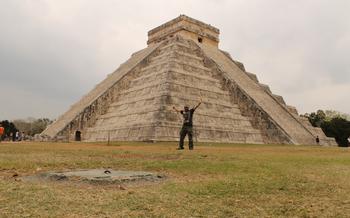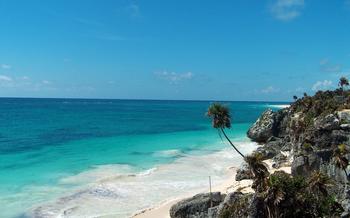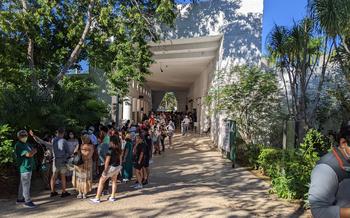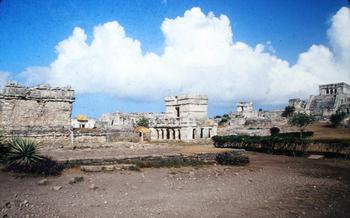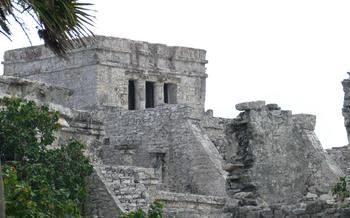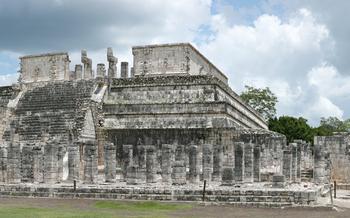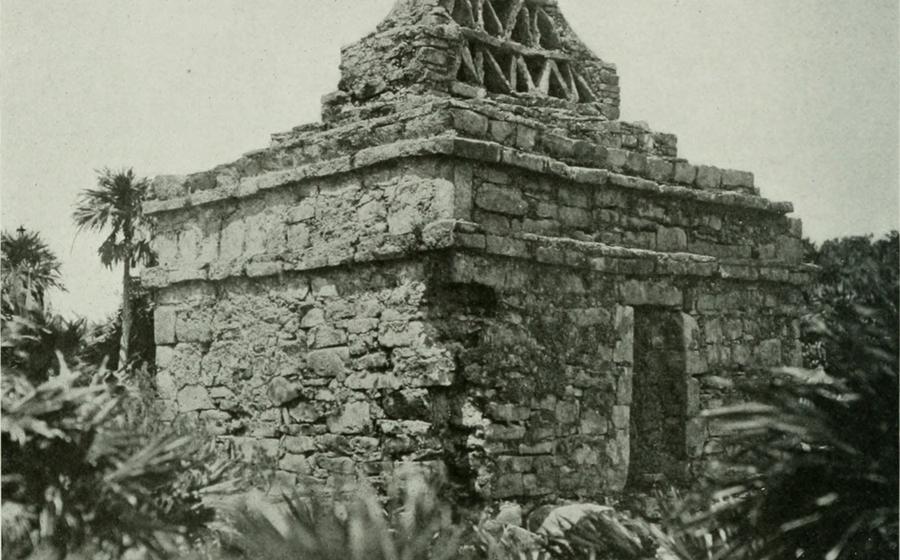
Tulum Archaeological Museum
- Historical Significance
- Location and Accessibility: A Journey to the Heart of Tulum's History
- Museum Layout and Exhibits
- Maya Culture and Traditions
- Guided Tours and Activities
- Photography and Videography
- Souvenirs and Gifts
- Accessibility and Facilities: A Welcoming Space for All
- Sustainability and Conservation: Preserving Maya Legacy
- Community Involvement: Preserving and Celebrating Maya Culture
- Research and Education
- Special Exhibitions and Events
- Behind-the-Scenes Tours
- Volunteer Opportunities: Join the Team
- Insider Tip: Secret Sunrises and Stargazing
Historical Significance
The ancient Maya city of Tulum, located on Mexico's Caribbean coast, holds immense historical significance as a port and trading center. Its strategic location allowed the Maya to engage in maritime trade with other regions of Mesoamerica and beyond, contributing to the city's wealth and prosperity. Tulum's architecture is unique, featuring well-preserved walls and temples that showcase the Maya's advanced engineering skills. The city played an important role in the Maya civilization, serving as a center for religious ceremonies, political gatherings, and economic activities. Tulum's eventual decline coincided with the collapse of the Maya civilization in the 16th century, leaving behind a rich legacy that continues to fascinate and intrigue visitors today. The Tulum Archaeological Museum houses an extensive collection of artifacts and exhibits that provide insights into the city's history, culture, and significance.
Location and Accessibility: A Journey to the Heart of Tulum's History
The Tulum Archaeological Museum is strategically situated within the Tulum Archaeological Zone, offering visitors an immersive journey into the ancient Maya city. Conveniently located just a short walk from the Tulum ruins, the museum is easily accessible by foot or bicycle. Alternatively, visitors can take a short taxi ride from the city center or nearby hotels.
For those arriving by car, ample parking is available near the museum entrance. The museum is also wheelchair accessible, ensuring that visitors with disabilities can comfortably explore its exhibits and facilities. Additionally, the museum's proximity to the stunning Tulum beach provides an excellent opportunity to combine cultural exploration with relaxation and sun-soaked bliss.
Museum Layout and Exhibits
The Tulum Archaeological Museum is divided into several sections and galleries, each showcasing a different aspect of Maya culture and history. The main gallery, known as the "Maya Hall," features an impressive collection of artifacts, including pottery, jewelry, and sculptures. Highlights include a beautifully preserved jade mask, intricate ceramic figurines, and a massive stone stela depicting a Maya ruler.
In the "History and Culture Gallery," visitors can learn about the Maya civilization's origins, social structure, and religious beliefs through interactive exhibits and multimedia displays. The museum also houses a collection of artifacts from the nearby Tulum ruins, including architectural fragments, carved stones, and ceramic vessels.
One of the most unique features of the museum is its "Living Maya Gallery," which showcases the contemporary culture and traditions of the Maya people. Visitors can learn about Maya textiles, traditional crafts, and modern-day Maya life through interactive exhibits and demonstrations.
Maya Culture and Traditions
The Maya civilization, one of the most advanced pre-Columbian civilizations, flourished in Mesoamerica for over 3,000 years. The Maya people developed a complex and sophisticated culture, characterized by their unique social structure, religion, and economy.
The Maya society was divided into different classes, with a ruling elite at the top and a large peasant class at the bottom. The Maya practiced a polytheistic religion, with a pantheon of gods and goddesses representing various aspects of nature and human life. Their economy was based on agriculture, with maize as the primary crop.
The Maya also developed a sophisticated system of writing, mathematics, and astronomy. They were skilled architects and builders, constructing impressive cities, temples, and pyramids. Maya art and culture were highly influenced by their religion and mythology, and their art often depicted gods, goddesses, and mythical creatures.
The Maya civilization reached its peak around the 9th century AD, but it eventually declined due to a combination of factors, including warfare, disease, and environmental changes. However, the Maya legacy continues to live on, and their culture and traditions continue to influence modern-day Mexico.
The Tulum Archaeological Museum plays a crucial role in preserving and promoting Maya heritage. Through its collection of artifacts and exhibits, the museum provides visitors with a glimpse into the rich and diverse culture of the Maya people.
Guided Tours and Activities
The Tulum Archaeological Museum offers guided tours led by knowledgeable and experienced guides who can provide visitors with a deeper understanding of the Maya culture and history. These tours typically cover the museum's main exhibits and artifacts, as well as the history of the Tulum archaeological site and its significance in the Maya civilization. Visitors can choose from various tour options, including general admission tours, private tours, and specialized tours focusing on specific aspects of Maya culture or history.
Guided tours offer several benefits to visitors. They provide expert insights and historical context, helping visitors to appreciate the significance of the museum's collection and its relevance to the Maya civilization. Guides can also answer questions and provide additional information that may not be readily available through self-guided exploration. Visitors who take a guided tour often come away with a more comprehensive and meaningful understanding of Maya culture and history.
In addition to guided tours, the Tulum Archaeological Museum also offers a range of special activities and workshops that provide visitors with unique and immersive experiences. These activities may include traditional Maya crafts workshops, cooking classes, and cultural performances. Visitors can check the museum's website or inquire at the information desk for more information on available activities and workshops during their visit.
Photography and Videography
The Tulum Archaeological Museum welcomes visitors to capture the beauty and significance of its collection through photography and videography. However, to ensure the preservation of the artifacts and exhibits, certain guidelines must be followed.
Photography and videography are permitted in most areas of the museum, but flash photography and tripods are prohibited to prevent damage to the delicate artifacts. Visitors are encouraged to be respectful and mindful of other visitors while taking photos and videos.
To capture stunning images, consider using natural light and adjusting your camera settings accordingly. Take your time to compose your shots and experiment with different angles to capture the unique perspectives of the museum's exhibits.
Please note that some areas of the museum, such as the conservation laboratory or certain temporary exhibitions, may have restrictions on photography and videography. Respect these restrictions and avoid taking photos or videos in these areas.
By following these guidelines, you can help preserve the Tulum Archaeological Museum's collection for future generations while capturing your own memories of this incredible cultural institution.
Souvenirs and Gifts
The Tulum Archaeological Museum gift shop offers a unique selection of souvenirs and gifts inspired by Maya culture and history. Here, visitors can find a variety of authentic Maya handicrafts, including intricate pottery, colorful textiles, and hand-carved wooden sculptures. These items are not only beautiful but also serve as a tangible reminder of the rich cultural heritage of the Maya people.
Supporting the museum by purchasing souvenirs is a meaningful way to contribute to the preservation and promotion of Maya culture. The proceeds from the gift shop directly support the museum's educational programs, research initiatives, and conservation efforts. By choosing to buy souvenirs from the museum, visitors play a vital role in ensuring the continuation of Maya traditions and cultural practices.
When shopping for Maya handicrafts, it is essential to look for items that are handmade and ethically sourced. This ensures that the artisans who create these beautiful pieces are fairly compensated for their work. Visitors can also find unique Maya-inspired souvenirs at local markets and shops in Tulum, where they can bargain for prices and support the local economy.
Accessibility and Facilities: A Welcoming Space for All
The Tulum Archaeological Museum is committed to providing an accessible and welcoming environment for all visitors. The museum features ramps, elevators, and designated parking spaces for visitors with disabilities, ensuring that everyone can comfortably explore the museum's exhibits and learn about Maya culture. Additionally, restrooms, water fountains, and other visitor amenities are conveniently located throughout the museum for the convenience of all visitors.
The museum staff is dedicated to assisting visitors with specific needs. They can provide wheelchairs or other mobility devices upon request, and they are always happy to answer questions or provide assistance to ensure that every visitor has a positive and enjoyable experience at the museum.
The museum's hours of operation are typically from 8:00 am to 5:00 pm, Tuesday through Sunday. Admission fees are charged, with discounts available for students, seniors, and children. Visitors are encouraged to purchase tickets in advance online to avoid lines and ensure a smooth entry.
Sustainability and Conservation: Preserving Maya Legacy
The Tulum Archaeological Museum is committed to sustainability and conservation practices to protect its collection and promote environmental awareness. The museum employs various measures to ensure the preservation of its artifacts and exhibits. These include climate-controlled storage facilities, specialized conservation techniques, and regular monitoring to prevent damage or deterioration.
The museum also actively engages in educational programs and initiatives aimed at promoting environmental awareness and conservation among visitors and the local community. Through workshops, guided tours, and interactive exhibits, the museum educates visitors about the importance of protecting the natural and cultural heritage of the Maya region.
Furthermore, the museum has implemented several green practices to reduce its environmental impact. These include using energy-efficient lighting and appliances, recycling and composting waste, and promoting sustainable tourism practices. By adopting these measures, the museum demonstrates its commitment to protecting the environment while preserving the legacy of the Maya civilization.
Community Involvement: Preserving and Celebrating Maya Culture
The Tulum Archaeological Museum actively participates in the local community, playing a pivotal role in preserving and celebrating Maya culture. The museum collaborates closely with local artisans, scholars, and organizations to promote cultural exchange and understanding. Through workshops, exhibitions, and educational programs, the museum provides a platform for local artisans to showcase their traditional crafts, ensuring that these skills and traditions continue to thrive.
The museum also works closely with Maya communities to document and preserve their oral histories, traditions, and customs. This collaborative approach not only ensures the preservation of valuable cultural heritage but also fosters a sense of pride and identity among the Maya people. By creating opportunities for cultural exchange and dialogue, the museum builds bridges between the past and the present, fostering a deep appreciation for the rich legacy of the Maya civilization.
Research and Education
The Tulum Archaeological Museum is not merely a depository of artifacts; it is also a hub for research and education, dedicated to deepening our understanding of Maya culture and history. The museum collaborates with scholars and institutions from around the world to conduct research on various aspects of Maya civilization, including archaeology, epigraphy, and ethnohistory. The results of these studies are disseminated through publications, conferences, and educational programs.
The museum also offers a range of educational programs for students, researchers, and the general public. These programs include lectures, workshops, and guided tours led by experts in Maya culture. The museum's library and research facilities are open to researchers and students who wish to delve deeper into Maya history and archaeology.
Through its research and education initiatives, the Tulum Archaeological Museum plays a vital role in preserving and promoting Maya heritage. The museum's commitment to scholarship ensures that the legacy of the Maya people continues to inspire and inform future generations.
Special Exhibitions and Events
The Tulum Archaeological Museum hosts a dynamic program of special exhibitions and events throughout the year, offering visitors unique opportunities to delve deeper into Maya culture and history. These exhibitions showcase a diverse range of artifacts, artworks, and interactive displays that explore specific themes or aspects of Maya civilization.
From ancient Maya writing and calendrics to traditional Maya crafts and textiles, these special exhibitions provide a platform for scholars, artists, and researchers to share their knowledge and insights with the public. Visitors can expect thought-provoking displays, captivating storytelling, and immersive experiences that bring Maya culture to life.
Upcoming exhibitions and events are announced on the museum's website, so be sure to check before your visit to plan your itinerary accordingly. Whether you're interested in exploring the mysteries of the Maya calendar, learning about their intricate writing system, or admiring the beauty of their handcrafted textiles, the Tulum Archaeological Museum's special exhibitions offer something for everyone.
Don't miss the opportunity to attend one of these special events during your visit to Tulum. These exhibitions and events not only provide a deeper understanding of Maya culture but also support the museum's ongoing efforts to preserve and promote this rich heritage.
Behind-the-Scenes Tours
The Tulum Archaeological Museum offers exclusive behind-the-scenes tours that provide visitors with an extraordinary opportunity to delve deeper into the museum's operations and conservation efforts. Led by knowledgeable museum staff, these tours take you behind the scenes to explore areas not typically accessible to the public. During a behind-the-scenes tour, you'll gain insights into the museum's curatorial practices, conservation techniques, and research projects. You'll witness firsthand the intricate process of preserving and restoring precious artifacts, and learn about the fascinating stories behind some of the museum's most iconic exhibits.
To book a behind-the-scenes tour, it's advisable to reserve your spot in advance, as they often have limited availability. Be sure to check the museum's website for tour schedules and pricing. Please note that there might be specific age restrictions or requirements for participating in these tours, so it's essential to inquire beforehand. Don't miss this unique chance to go beyond the museum's walls and discover the hidden world of preservation and research that keeps the legacy of the ancient Maya alive.
Volunteer Opportunities: Join the Team
The Tulum Archaeological Museum welcomes volunteers who are passionate about Maya culture and history. By joining the museum's volunteer program, you can contribute to its mission of preserving and promoting Maya heritage. Various volunteer opportunities are available, including docents, tour guides, and research assistants.
As a volunteer, you will gain valuable hands-on experience in museum operations, education, and conservation. You will have the opportunity to work alongside museum staff and experts, learn about Maya culture and history, and contribute to the museum's educational programs and initiatives.
To become a volunteer, you must be at least 18 years old, have a passion for history and culture, and be willing to commit to a regular schedule. The museum provides training and support to all volunteers, ensuring that they have the knowledge and skills necessary to fulfill their roles effectively.
If you are interested in volunteering at the Tulum Archaeological Museum, please contact the museum's volunteer coordinator for more information and to apply. Your contribution will make a real difference in preserving and promoting the rich cultural heritage of the Maya people.
Insider Tip: Secret Sunrises and Stargazing
For an unforgettable experience, plan your visit to the Tulum Archaeological Museum early in the morning to witness the breathtaking sunrise over the ancient Maya city. As the sun peeks over the horizon, casting a warm glow on the ruins and the surrounding jungle, you'll feel transported back in time. Alternatively, visit the museum at night for a magical stargazing experience. With minimal light pollution, the night sky above Tulum is a canvas of brilliant stars and constellations. Find a spot on the museum grounds, lay down a blanket, and let the wonders of the universe captivate you.

